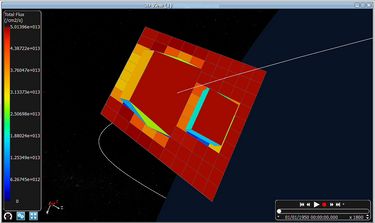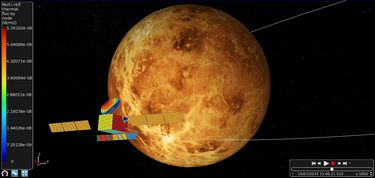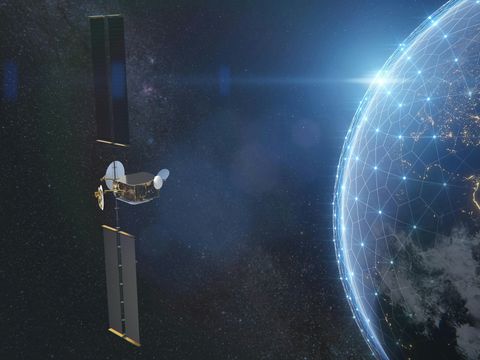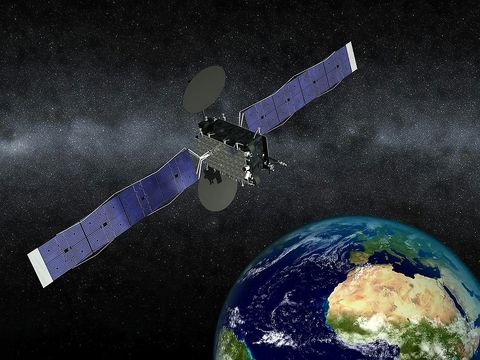Space environment applications
The Space environment applications cover a wide range of modelling problems arising when a spacecraft evolves in Space.
Several specialized applications are available such as Atomox, Perturbations, Dosrad, Debris, Outgassing, Plume, and GTD, each of them tailored to address critical aspects of the space environment.
Each application is bundled with the Systema framework and is available for individual use. Alternatively, an “environment package” is available which includes 4 of these applications with the Systema framework: Atomox, Perturbations, Dosrad and Debris.
Atomox
A good knowledge of temperature, total density, concentrations of gas constituents, and pressure, can be important for many space missions in the low-earth orbit regime, below 1000 km altitude.
Atomox is an enhanced 3D numerical analysis tool for evaluation of atomic oxygen (and other species of the atmosphere) flux, fluence and material erosion, based on existing atmosphere and wind models. It involves mission and pointing modules, along with ray-tracing technique and 2D /3D visualisation facilities.
All spacecraft surfaces are meshed into elements and the analysis is performed for each element. The mission and pointing modules provide the discretized location of the spacecraft together with its velocity with respect to the Earth. At the end of each orbital arc, orbital averaged or accumulated values are calculated which can be extrapolated when several arcs are specified.
The ray-tracing technique (Monte-Carlo technique) is used. It considers emitted rays from the surface of the satellite and detects if a given element is struck by the ray. Then, the ray can be followed by multiple reflections on the satellite surfaces (specular and diffuse reflectance taken into account).
Outputs are the:
- Total impacting flux and fluence
- Absorbed flux and fluence
- Direct impacting flux and fluence
- Spacecraft material erosion
- Mean impact velocity (amplitude and direction)
- Mean particle energy
The model includes the effects of thermal motion of ambient particles in addition to the ambient atmospheric density and the velocity of the spacecraft. Thermal molecular motion can be responsible for erosion of surfaces that are shadowed during the mission.

Perturbations
The objective of the perturbations application is to deliver analysis of perturbations caused by solar pressure, and air drag generated by atmosphere remains at low atmosphere.
Solar pressure
The solar pressure module computes the solar radiation pressure which is the force produced by the impact of sunlight photons on the surface of the spacecraft.
Sun radiation incident on the satellite's surfaces produces a radiation pressure, or force per unit area, equal to the vector difference between the incident and reflected momentum flux.
The major factors determining the radiation pressure are:
- The intensity, the spectral and the spatial distribution of the incident radiation
- The geometry of the satellite
- The optical properties of the satellite surfaces
Solar pressure allows to account for the induced forces and torques using a state-of-the-art analytical ray tracing algorithm.
Air drag
A satellite moving through a planet's upper atmosphere is subjected to aerodynamic forces. These forces result from the interaction of the atmosphere molecules with the satellite's surfaces.
The air drag module computes perturbing forces, torques and thermal fluxes resulting from the interaction of the atmosphere particles with the satellite's surfaces.
Therefore the air drag depends on the following parameters:
- The satellite velocity
- The atmospheric constituents, their density and their kinetic temperature
- The motion of the atmosphere
- The geometry of the satellite
- The orientation of the satellite w.r.t. the incoming flow
- The surface characteristics and temperature
This force is usually modelled by assuming that it acts in a direction opposite to the spacecraft's velocity vector relative to the ambient atmosphere. The results are computed using a modified Maxellian model for Particle/Wall Interaction.

Dosrad
Dosrad computes the radiation dose received by electronic components or material when exposed to the environment dose integration performed by an efficient solid angle sectoring analysis:
- Rays are traced from the dose point outwards through the spacecraft
- For each ray, the amount of shielding encountered is determined taking into account the material density
- From the dose depth curve, the weighted dose contribution is calculated
The average doses per mesh and then per face are obtained.
Surfaces with thickness or volume computation: equipment dose/shielding, component dose, dose mapping, advanced features, honeycomb management, rays display.
Dosrad functionalities:
- Analysis at equipment and component level
- Dose and shielding (protective thickness) computation
- SLANT and NORM computation
- Computation of satellite equivalent thickness for sub specification (SLANT FOR SUB)
- Manage real volume or shell with thickness
- Detailed honeycomb modelling
- Efficient ray-tracing algorithm to compute ray paths in a 3D model
- Computation of all targets / bounding box thickness in one run
Performs computation of:
- Dose on a point dose received by a component
- Dose / shielding on a bounding box of an equipment
- Dose cartography / mapping computation allowing to have a mean dose on a surface (electronic card, optics, detector…)

Debris
Debris predicts the risk of spacecraft equipment/structure failure.
The continuing growth in space debris and therefore the risk increase of mission-critical damage tend to develop the use of numerical tools in M/OD risk assessment methodology for spacecraft. Larger on-orbit objects are tracked and orbit change manoeuvres of the spacecraft can be performed to avoid a collision. For non-trackable objects, shields or other means to control risks are used. In order to improve the conception of the spacecraft, impact risk assessment tools are developed.
The prevention of critical damage on sensitive surfaces that might compromise mission objectives and lifetime, interest more and more the satellite design engineers.
To optimise the positioning of critical elements with respect to the overall performance efficiency, it is essential to have a comprehensive understanding and quantitative characterisation of the M/OD impact risk.
Debris is intended to provide a tool for evaluating the probability of no-penetration (PNP) of selected elements within spacecraft geometry, considering computation time compatible with the need to perform trade-off between configurations.
M/OD risk assessment analysis done via debris allows:
- Computation of the number of direct impacts on an element
- Computation of the number of penetrations on an element
- Computation of damaged area on an element
- Computation of the PNP of an element
Material contamination (outgassing)
In vacuum, the coatings and materials may outgas contaminants species.
The objective of the systema-outgassing software is to evaluate the deposit of contaminants on the spacecraft surfaces, such as mirrors and thermal coatings, as a function of time.
The calculation proceeds in two main steps:
- The computation of the mass transfer factors between surfaces using Monte-Carlo method and the time integration of the deposit.
- Computation of the direct mass transfer is done via:
An advanced ray-tracing solver:
- Multi-threaded computation
- Using management of all the shell shapes including boolean shapes
- Allowing the display of mass transfer factors on the 3D models
- Allowing the display of rays contributing to the mass transfer factors
Computation of the deposits is done :
- With multi-threading computation (by species) of the deposits computation
- Allowing the display of deposit and remaining mass to be outgassed on the 3D model as function of time

Plume suite: plumflow
The objective of the plumflow software is to compute the flow field issued from a thruster in vacuum, that is to say:
- Chemical composition of the gas in the chamber and in the plume
- Physical properties of the gas: viscosity, heat capacity, g, species diameter
- If necessary, description of the non-gaseous phase : particles or droplets
- Properties of the plume along the streamlines (velocity, density, pressures…)
- Characteristics of the engine (thrust, mass flow rate…)
This calculation involves a large panel of different methods:
- The computation of the chemical composition and physical properties is performed under assumption of thermodynamic equilibrium
- The computation of the flow inside the engine and its expansion in the surrounding space uses the method of characteristics or navier-stokes equation resolution. These programs perform the simulation of the boundary layer expansion at the nozzle lip
- The extension of the flow-field beyond the navier-stokes and the method of characteristics computational domain uses the source-flow method, considering the expansion as isotropic
- Other methods can be used to handle more specific problems like cirect simulation Monte-Carlo at the nozzle lip or droplets propagation
Pressure distribution on the solar array of an observation satellite and thruster flow field below.

Plume suite: plumimp
The objective of the systema-plume Impingement software is:
- To predict the interaction between the chemical thrusters and the spacecraft in terms of dynamic, thermal and contamination effects
- To develop an engineering tool easy to use and validated
The main perturbing effects due to the impoundment of thrusters plumes are numerous:
- Perturbing forces and torques due to the plume impingement on the spacecraft surfaces
- Heat convective flux due to the impingement of the gas and radiative flux due to the particles
- Modification of the surfaces properties due to the contaminants deposit
- Effects of the contaminants cloud on the optical devices (absorption, emission, scattering)
- Induced pressure at instrument / equipment level
Plumimp allows the modelling of such effects using an analytical ray-tracing technique. Rays are traced from the thruster of interest to all the meshes of the geometry. Each ray provides information regarding the current mesh and the thruster: incidence angle, distance to the thruster, etc... If another surface is encountered, the current mesh is said to be shadowed. Otherwise, the impact parameters as well as the derivative quantities are computed, cumulated (on meshes, on surfaces and possibly on groups) and stored in the corresponding file: in the Impingement information file for the impact parameters and in the derivate quantities file for the other quantities.
Thermal fluxes on a complete model of a telecom satellite below.

Radio-frequency GTD
The radio frequency (RF) analysis of satellites is one of many important steps required to ensure a successful mission. For directive antennae, the satellite structure and nearby payloads may often be neglected, but for low-gain antennae and omnidirectional antennae, the structure may influence the radiation characteristics substantially.
Therefore it is of great interest for these types of antennae, to have the capability to compute the interfered antenna pattern, for an antenna mounted on a satellite structure.
In addition to the antenna pattern, this software enables the calculation of antenna to antenna coupling due to the structure, which is very important for the positioning of antennae, and the study of the electromagnetic compatibility between them. The field computation on surfaces of the structure or on virtual surfaces is also available in this new version.
The RF analysis is based on the geometrical theory of diffraction ( GTD ) which assumes high frequency. The ray-tracing may be carried out in two essentially different ways. The traditional backward ray tracing determines the ray paths when the source position, the scattering objects and the far field direction are given. Alternatively, the forward ray tracing principles of CAD applications may be applied. A large number of rays are then emitted from the source in all directions and each ray is followed to its final destination. The GTD software makes use of this latter efficient and powerful technique.
In this version of the software, multiple reflected rays, as well as multiple diffracted rays are handled for all planed and curved systema surfaces. The number of reflections and diffractions for a single ray is limited to 2, creeping rays on plane surfaces are also taken into account.
The antenna to antenna coupling allows computing the coupling coefficient between two antennas. In a first step, the “ray tracing” determines the coupling ray paths. In a second step, the coupling value is calculated by field propagation along the rays using a complex or RSS field summation.
GTD offers a great help to the engineer for the RF System analysis like the positioning of antennae on the structure, the detection of interaction problems very early in the program and the prediction of the antenna pattern.




